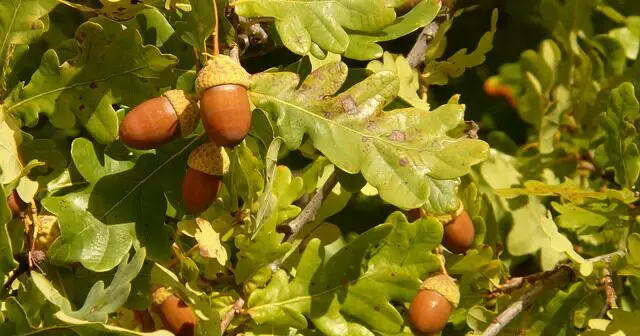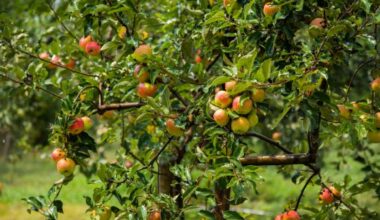Who hasn’t had the desire, during a walk in the forest, to pick up a beautiful acorn to try to sow it and obtain a majestic oak?
The oak indeed multiplies quite easily by sowing acorns, provided you do it at the right time and take a few precautions. If you have the space to welcome such a tree in your garden, why not give it a try!
Contents
How to grow an oak tree from an acorn
1. Collect acorns in October for sowing.
Fruits of the oak, the acorns ripen on the tree. In order to sow them successfully, it is essential that they are harvested at maturity, in autumn, when they have fully grown and fall to the ground.
- Ideally, collect acorns between October 10 and 31.
- Collect those that are already on the ground and only the larger ones, leaving aside the smaller, prematurely fallen acorns.
- Do not hesitate to collect a good quantity of acorns, because not all of them can be sown and not all of those that are sown will germinate.
2. Check the vitality of the harvested acorns
Once the acorns have been collected, it is important to sort the good from the bad.
- Eliminate those that are blackish, a little soft, or have small holes indicating that they are parasitized.
- Then immerse the acorns that seem healthy in a basin of water:
- Eliminate those who are supernatant ;
- keep only those that fall to the bottom of the basin: they have a good chance of germinating, provided that you put them in the ground immediately; in fact, an acorn dries out extremely quickly, losing its germinating capacity.
3. Sow the oak acorns
It is recommended to sow several acorns in order to have at least one that germinates and develops well.
- Sow each acorn in an individual pot, so that the future roots do not mix and cannot be separated without damage.
- Choose deep pots (at least 6 inches) because the oak root grows rapidly deep.
- Fill these pots with a substrate consisting of a mixture of garden soil and potting soil for sowing or cutting.
- In each pot, place an acorn horizontally on the surface and cover it with no more than 1/2 inch of substrate: a thicker layer is a frequent cause of seedling failure, as the seedling has difficulty in drilling.
- Sprinkle, then place the pots in a normally lit room at an ideal temperature of 68°F.
4. Observe the sprouting of the oak acorns
As soon as the acorns are planted, keep the substrate always wet, without drowning it: water moderately, on average every 2 days.
If the acorn germinates, you will first see a root embryo appear, which will quickly sink into the soil. A few days later the future stem will appear, and later on small leaves will appear.
5. Transplant a young oak tree in the ground
In spring, it is time to transplant a young oak tree in the ground. If more than one has grown, choose the most vigorous one.
Wait until late April-early May, so that frost is no longer a concern, but not much longer because the roots will form a “bun” at the bottom of the pot that will be harmful to the health of your baby oak.
Choose the spot where to transplant your young oak tree
Remember that you are not planting just any small tree, but an oak tree that can take a huge growth.
- So choose a secluded spot, far from the house, where your tree will have all the space and light it needs.
- Ideally, the soil should be deep, drained but cool (except for a holm oak, which appreciates dry soil).
Plant the young oak in the ground
For the oak to grow in the best conditions, it needs deep, loose soil in which it will sink its roots deep: to this end, dig the soil to a minimum depth of 12 inches.
- Make a hole in the ground with a depth and diameter more or less equal to that of the pot.
- Carefully remove the small oak tree from its pot, taking care to take all the root ball.
- Place it in the hole and fill it up by bringing the soil around the plant.
- Pack lightly and water abundantly.
- Preferably, mulch the foot of the shrub (dead leaves, grass clippings …).
- Finally, mark the spot with a clearly visible stake to avoid an unfortunate mowing.
In one year, your small oak will measure about 12 inches, and in ten years 13 ft or more …
Floor and exposure for an oak tree
Most oaks appreciate deep, cool but drained soil and open spaces: they need light and do not like competition from other trees. They are usually installed in isolation, for example on a large lawn.
However, some species with less development can be grown in hedges or in clumps (holm oak). It should be noted that oak is also cultivated in the form of bonsai.
The oak is best planted in autumn, so that its roots have time to settle deep down to face the drought of the following summer. Because, apart from Mediterranean species, oak needs a certain amount of soil moisture: in the first few years after planting, you should consider watering it in dry weather.
However, beware of compact or waterlogged soils: oak does not tolerate them (except for swamp oak which, as its name suggests, tolerates hydromorphic soils).
If the soil in your garden tends to be very wet in winter, plant your tree in March, but then make sure to water very regularly throughout the spring and the following summer.
Multiply an oak tree with its acorns
The oak tree multiplies easily by sowing: the acorns will be planted in pots in autumn, barely covered with soil. Placed all winter long outside, they will germinate towards the beginning of spring.
This multiplication technique is certainly economical, but it has its drawbacks: very young oaks are fragile (they fear the sun during their first years, while dreading excess water), and a young plant acquired in a nursery, equipped with an already developed root system, will be better equipped to install itself properly … and you will gain a few years compared to sowing!
On the vegetative muliplication side, grafting is possible, as well as cutting, but this one “roots” with difficulty.
Oak diseases and pests
Some oak species are sensitive to powdery mildew (pedunculate oak, sessile oak).
In too wet soil, a fungus can also settle in the root system and cause the death of the tree: it is the honey-colored (or rotten) armillary.
In the spring, aphids readily colonize young shoots: the invasion is harmless for older trees, but the bites of these insects can cause unsightly leaf deformation.
Summary
The acorn, the fruit of the oak tree, is generally sown 2/3 centimeters underground, which is not necessarily the best method. It is a considerable waste of time, if however it were to germinate, and then come out of the ground …
The best is to sow your acorns on the surface of the earth (topsoil), horizontally and “bury” it only a few millimeters, not even half! Water your seedlings daily. Maintain a certain humidity while leaving them in an ambient temperature (“68°F” is not so bad). We explain everything in detail in this article.









